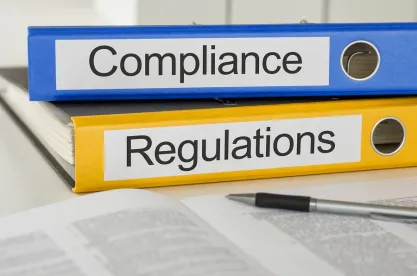On November 17, 2016, the Federal Energy Regulatory Commission (the “Commission” or “FERC”) Office of Enforcement (“FERC Staff”) issued a White Paper on Effective Energy Trading Compliance Practices (“Compliance White Paper”) to provide jurisdictional companies with concrete examples of how to design, implement, and assess compliance practices that “may” prevent or detect market manipulation.1 FERC Staff characterizes the Compliance White Paper as a supplement to the Commission’s five prior policy statements related to compliance.2 However, the Compliance White Paper contains a lengthy list of prescriptive measures that FERC Staff recommends that companies should consider when developing and enforcing an effective compliance program. Many of the recommended measures make sense especially in light of recent enforcement actions, but others may be impractical or expensive to implement.
We highlight below a few of the measures that FERC Staff considers as examples of effective compliance practices (all of which we discuss in greater detail below):
-
Tailoring the compliance program to a company’s specific business;
-
Providing training that reflects a variety of training styles, ranging from one-on-one meetings to compliance newsletters and annual, large group trainings;
-
Hiring compliance personnel with various professional and educational backgrounds (g., legal, operations, trading, and risk management);
-
Devoting sufficient resources, including experienced personnel and technology, to implementing and enforcing an effective compliance program;
-
Regularly performing background investigations on traders and, prior to hiring traders, identifying candidates’ compliance track records;
-
Integrating compliance and operational professionals, management, and internal counsel in all aspects of the compliance program;
-
Documenting the business and compliance basis for undertaking new trading strategies, particularly when they involve related physical and financial positions;
-
Conducting frequent, topic-specific training using a variety of techniques;
-
Recording, retaining, and regularly reviewing all written and oral trader communications for at least five years;
-
Monitoring employee communications for potential misconduct, such as through algorithmic-based software programs;3
-
Monitoring trading activity, including tracking and reviewing profit and loss calculations by product and location combinations instead of aggregate portfolios;4
-
Enforcing – and documenting enforcement – of compliance rules and restrictions, including appropriate discipline of traders who fail to comply with Commission and ISO rules and the company’s compliance policies and procedures; and
-
Regularly auditing compliance programs through, for example, full audits every other year or smaller audits every six months.5
FERC Staff notes that “adopting the effective practices described herein will not shield an organization from, or provide a defense to, an enforcement action” if the Commission concludes that a violation occurred.6 However, it states that a penalty “could be reduced” where an organization has an effective compliance program at the time of a violation.7 Moreover, consistent with the Commission’s repeated emphasis that it will not mandate specific compliance practices, FERC Staff characterizes the Compliance White Paper as providing only examples of effective and ineffective compliance practices – rather than articulating specific practices that must be in place to warrant compliance credit in manipulation enforcement actions. FERC Staff explains that “while the existence of these practices in an organization’s compliance program may factor positively into the Commission’s consideration of whether the organization’s compliance program was effective, the presence or absence of any these practices would not be determinative of the program’s effectiveness.”8
Although not all of the measures described in the Compliance White Paper will apply to any given organization, it raises the question whether companies can afford not to implement many of FERC Staff’s recommendations. In other words, FERC Staff’s issuance of this White Paper makes it unlikely that FERC Staff will support giving full compliance credit under FERC’s penalty guidelines if an organization’s compliance program does not include most, if not all, of the measures described in the Compliance White Paper. Consequently, companies would be well-advised to review their existing compliance policies and procedures in light of FERC Staff’s recommendations.
Designing an Effective Compliance Program
The Compliance White Paper’s guidance on designing an effective compliance program is divided into the following four areas: (1) structure and composition of a company’s compliance function; (2) programs and priorities within human resource (“HR”) units; (3) types of compliance trainings offered; and (4) technological resources provided to compliance units.9
With respect to a company’s structure and composition, FERC Staff recommends that compliance personnel have knowledge of their company’s day-to-day business operations to ensure that they provide relevant, helpful advice to traders. FERC Staff notes that to achieve this, as well as to foster an open dialogue, companies could place compliance personnel on the trading floor and rotate business unit employees into the compliance unit. In addition, FERC Staff suggests empowering compliance to establish and enforce compliance procedures by, for example, preventing traders and business unit managers from unilaterally ignoring compliance advice, documenting procedures to resolve disagreements between the compliance and business units, and creating a direct line for compliance to report to the Chief Executive Officer or the board.10 FERC Staff also recommends that companies sufficiently fund compliance units and encourage compliance personnel to network with other compliance professionals through compliance-related associations.11
To promote compliance through HR policies, the Compliance White Paper recommends that companies perform background checks on both new and existing traders and, in the case of new hires, ask references about a candidate’s compliance history.12 This may be impractical as many companies will only confirm employment and will not answer specific questions when asked about the behavior of a former employee. The recommendation might also raise issues under some state employment laws. There are other ways to check on a potential new hire’s compliance history although they will uncover only publicly available information. FERC Staff also recommends that a company’s trader compensation structure should incentivize compliance rather than just profitability. For example, compensation structures could require adherence to compliance rules and restrictions for bonus eligibility, provide separate bonuses for traders with strong compliance records, and reduce performance-based bonuses for a trader’s compliance-related violations.
The Compliance White Paper specifies that “training is an essential element of an effective trading compliance program.”13 FERC Staff urges companies to tailor training programs to their size, specific trading activities, and traders’ level of experience. In addition, it encourages timely, topic-specific, and frequent trainings that utilize a variety of training styles to best meet different learning needs (e.g., through small group trainings, one-on-one meetings, annual trainings, and newsletters). Furthermore, FERC Staff recommends that companies track their traders’ participation in training programs offered and, where traders fail to meet their training requirements, impose disciplinary measures ranging from bonus reductions to suspensions.14 FERC Staff also identifies the following as examples of ineffective compliance training: (1) over-relying on standardized, repetitious, and long annual trainings; and (2) failing to provide practical and relevant applications of the law and relying solely on attorneys for compliance training, rather than seeking input from business unit managers and operational staff.15
Finally, FERC Staff highlights information technology (“IT”) resources as a valuable tool that should be regularly evaluated and updated to “track participation in compliance training, monitor trader activities, and detect potential compliance violations and market manipulation.”16 To ensure this, FERC Staff suggests that companies allocate separate funds for compliance-related IT resources to prevent business units from receiving a disproportionate amount of funding at the expense of compliance. However, IT tools can be expensive to design or purchase, and frequently identify high numbers of false positives that detract compliance personnel from more important tasks.
Establishing, Implementing, and Enforcing Effective Practices to Deter and Detect Market Manipulation and Other Misconduct
FERC Staff acknowledges that effectively monitoring traders’ activities and identifying potentially problematic conduct poses the biggest compliance challenge to most companies. It encourages companies to establish trading rules and restrictions to minimize a trader’s ability and incentive to engage in manipulation. For example, companies could maintain a list of prohibited trading practices, document trading strategies and regularly review such documentation, and require approval before trading new products or at new locations.17
Noting that several of the Commission’s enforcement actions have targeted trading strategies that used price-setting instruments to benefit corresponding financial positions, FERC Staff emphasizes certain restrictions to effectively deter and prevent such manipulative behavior, including:
-
Requiring documentation of trading strategies that involve related physical and financial positions (g., explaining the rationale for such strategies and the circumstances in which the strategies can be implemented);
-
Creating limits on consistent losses in price-setting instruments;
-
Implementing limits on traders’ financial positions and monitoring whether traders shift positions to other traders or books to evade such limits; and
-
Establishing thresholds on traders’ trading of certain physical and virtual trading products at particular locations that trigger compliance reviews when breached.18
Once such rules and restrictions are in place, FERC Staff explains, companies should monitor trading activities through, for example, the use of tailored automated trading algorithms or other tools to effectively analyze trading data and communications and identify misconduct. FERC Staff provides the following examples of effective monitoring techniques:
-
Monitoring trades and position concentrations in specific markets and products, and taking into account the behavior of other market participants, to identify where traders may be capable of artificially affecting a price to benefit a related financial position;
-
Reviewing on a sampling basis traders’ activities at locations where they engage in both physical and financial trading;
-
Reviewing and documenting traders’ power market activities at locations where they engage in both virtual and other financial trading;
-
Monitoring profit and loss (“PnL”) calculations at a “sufficiently granular level” for each combination of products and locations (g., monitoring a trader’s virtual PnL, where such trader engages in both virtual and other financial trading, at the relevant locations to identify a pattern of virtual losses);
-
Tracking the amount of make-whole or out-of-market payments received and, where a significant increase in payments is identified, reviewing whether this increase was preceded by a new trading strategy that benefits from the payments (g., through “unwarranted” changes to such offer parameters as start-up costs or minimum run times);
-
Periodically reviewing cost-based offers submitted to independent system operators or regional transmission organizations to ensure compliance with applicable market rules;
-
Post hoc analyzing natural gas pipeline nominations and flows during pipeline constraints to determine whether nominations were not intended to flow but to take advantage of the system;
-
Recording and maintaining all written and oral trader communications for at least five years;
-
Regularly monitoring employee communications for potential misconduct, such as through algorithmic-based software programs; and
-
Encouraging a culture of compliance where employees raise concerns and report compliance issues without fear of retribution (g., through anonymous reporting or compliance hotlines or email portals).19
In addition, FERC Staff urges companies to strictly and consistently enforce all compliance rules and take disciplinary action that reflects the severity of the violation. It recommends that companies follow up on instances of possible misconduct and document alerts of potential misconduct, the steps taken to understand and, if appropriate, address the misconduct and discipline the responsible actors.20 Moreover, it emphasizes that companies may have ineffective compliance programs where they have implemented robust compliance-based rules and restrictions, yet failed to actually enforce them.21
Assessing the Performance of the Compliance Program on a Regular Basis
Reasoning that effective compliance programs include periodic evaluations of such programs, FERC Staff suggests in its Compliance White Paper that companies regularly audit compliance programs through, for example, full audits every other year or smaller audits of specific program components every six months. In addition, it emphasizes the importance of improving compliance programs, and documenting such improvements, to specifically address weaknesses identified in past audits. FERC Staff reasons that in subsequent audits, companies can evaluate whether these improvements adequately address such weaknesses.22
Implications
Despite FERC Staff’s description of the Compliance White Paper as providing only examples of compliance practices in response to requests for additional guidance, the nature and number of examples it has provided raise concerns that it will recognize as effective only those compliance programs that have adopted the majority of these exhaustive, costly, and time-consuming practices. And, as FERC Staff specifically cautions, companies that implement all of these compliance practices may still face FERC enforcement actions for a manipulation violation.
Furthermore, some of FERC Staff’s examples – such as rotating business unit personnel into compliance units – may be unworkable in practice and seemingly reflect a fundamental difference between FERC Staff and market participants about a company’s overall business objectives and resources. Other examples – such as recording, retaining (for a minimum of five years), and reviewing all oral and written trader communications – could be costly and time-consuming to implement. In some cases, the costs associated with this facet of the Compliance White Paper could outweigh the potential benefits associated with obtaining a compliance credit in an investigation.
1 Office of Enforcement White Paper on Effective Energy Trading Compliance Practices (Nov. 17, 2016) “(Compliance White Paper)”, available here.
2 The Commission’s prior policy statements include: Enforcement of Statutes, Orders, Rules, and Regulations, 113 FERC ¶ 61,068, at P 21-23 (2005) (Policy Statement on Enforcement); Enforcement of Statutes, Regulations, and Orders, 123 FERC ¶ 61,156, at P 54 (2008) (Revised Policy Statement on Enforcement); Compliance with Statutes, Regulations, and Orders, 125 FERC ¶ 61,058, at P 1 (2008) (Policy Statement on Compliance); Enforcement of Statutes, Orders, Rules, and Regulations, 130 FERC ¶ 61,220 (2010) (Policy Statement on Penalty Guidelines); Enforcement of Statutes, Orders, Rules, and Regulations, 132 FERC ¶ 61,216 (2010) (Revised Policy Statement on Penalty Guidelines).
3 Id.
4 Id. at 16.
5 Id. at 19.
6 Id. at 1, n. 2.
7 Id. (emphasis added).
8 Id. at 4.
9 Id. at 6.
10 Id. at 7.
11 Id. at 8.
12 Id. at 8-9.
13 Id. at 9.
14 Id. at 9, 11.
15 Id. at 20-21.
16 Id. at 11.
17 Id. at 11-12.
18 Id. at 13-14.
19 Id. at 14-18.
20 Id. at 18.
21 Id. at 22.
22 Id. at 19.





 />i
/>i

